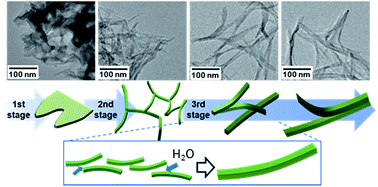Evolution analysis of V2O5·nH2O gels for preparation of xerogels having a high specific surface area and their replicas†
Abstract
The evolution of a V2O5·nH2O gel skeleton through the hydration of vanadium alkoxide was monitored using ex situ and in situ transmission electron microscopy and X-ray diffractometry. We successfully observed the morphological evolution of the gel skeleton by vacuum drying after replacing the pore liquid of acetone with cyclohexane. The gel skeleton comprised of nanofibers 10–20 nm wide and over 300 nm long was formed from ultrathin films 1–3 nm thick through thin fibrils 3–7 nm wide and about 100 nm long. Fixation of the thin fibrils by a simple vacuum-drying technique provided xerogels having a specific surface area as high as ∼320 m2 g−1 at ambient temperature. Highly porous polypyrrole frameworks were obtained as replicas of the V2O5·nH2O xerogels.



 Please wait while we load your content...
Please wait while we load your content...